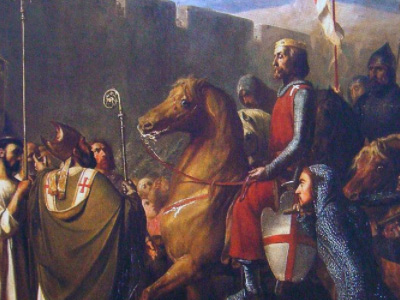First Crusade (1095–1099)
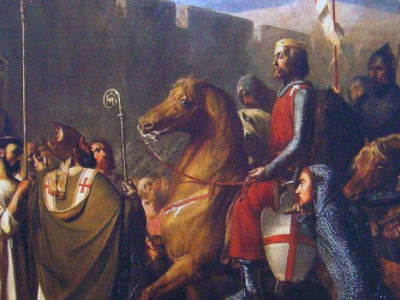
Historical Context
The causes of the Crusades in general, and particularly that of the First Crusade, is widely debated among historians. While the relative weight or importance of the various factors may be the subject to ongoing disputes, it is clear that the First Crusade came about from a combination of factors in both Europe and the Near East. Its origin is linked both with the political situation in Catholic Christendom, including the political and social situation in 11th-century Europe, the rise of a reform movement within the papacy, as well as the military and religious confrontation of Christianity and Islam in the East.
Christianity had been adopted thoughout the Roman Empire in Late Antiquity, but in the 7th to 8th centuries, the Umayyad Caliphate had conquered Syria, Egypt, and North Africa from the predominantly Christian Byzantine Empire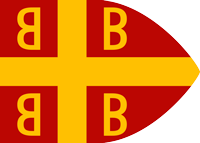 The Byzantine Empire, also referred to as the Eastern Roman Empire or Byzantium, was the continuation of the Roman Empire primarily in its eastern provinces during Late Antiquity and the Middle Ages, when its capital city was Constantinople. It survived the fragmentation and fall of the Western Roman Empire in the 5th century AD and continued to exist for an additional thousand years until the fall of Constantinople to the Ottoman Empire in 1453., and Hispania from the Visigothic Kingdom. In North Africa, the Umayyad empire eventually collapsed and a number of smaller Muslim kingdoms emerged, such as the Aghlabids, who attacked Italy in the 9th century. Pisa, Genoa, and the Principality of Catalonia began to battle various Muslim kingdoms for control of the Mediterranean Basin, exemplified by the Mahdia campaign and battles at Majorca and Sardinia.
The Byzantine Empire, also referred to as the Eastern Roman Empire or Byzantium, was the continuation of the Roman Empire primarily in its eastern provinces during Late Antiquity and the Middle Ages, when its capital city was Constantinople. It survived the fragmentation and fall of the Western Roman Empire in the 5th century AD and continued to exist for an additional thousand years until the fall of Constantinople to the Ottoman Empire in 1453., and Hispania from the Visigothic Kingdom. In North Africa, the Umayyad empire eventually collapsed and a number of smaller Muslim kingdoms emerged, such as the Aghlabids, who attacked Italy in the 9th century. Pisa, Genoa, and the Principality of Catalonia began to battle various Muslim kingdoms for control of the Mediterranean Basin, exemplified by the Mahdia campaign and battles at Majorca and Sardinia.
Between the years of 1096 and 1101 the Byzantine Greeks experienced the crusade as it arrived in Constantinople in three separate waves. In the early summer of 1096, the first large unruly group arrived on the outskirts of Constantinople. This wave was reported to be undisciplined and ill-equipped as an army. This first group is often called the Peasants’ or People’s Crusade. It was led by Peter the Hermit and Walter Sans Avoir and had no knowledge of or respect for the wishes of Byzantine Emperor Alexios I Komnenos.
The second wave was also not under the command of the Emperor and was made up of a number of armies with their own commanders. Together, this group and the first wave numbered an estimated 60,000.
The second wave was led by Hugh I, Count of Vermandois, the brother of King Philip I of France The Kingdom of France is the historiographical name or umbrella term given to various political entities of France in the medieval and early modern period. It was one of the most powerful states in Europe since the High Middle Ages. It was also an early colonial power, with possessions around the world. Colonial conflicts with Great Britain led to the loss of much of its North American holdings by 1763. The Kingdom of France adopted a written constitution in 1791, but the Kingdom was abolished a year later and replaced with the First French Republic.. Also among the second wave were Raymond IV, Count of Toulouse and the army of Provençals. "It was this second wave of crusaders which later passed through Asia Minor, captured Antioch in 1098 and finally took Jerusalem 15 July 1099".
The Kingdom of France is the historiographical name or umbrella term given to various political entities of France in the medieval and early modern period. It was one of the most powerful states in Europe since the High Middle Ages. It was also an early colonial power, with possessions around the world. Colonial conflicts with Great Britain led to the loss of much of its North American holdings by 1763. The Kingdom of France adopted a written constitution in 1791, but the Kingdom was abolished a year later and replaced with the First French Republic.. Also among the second wave were Raymond IV, Count of Toulouse and the army of Provençals. "It was this second wave of crusaders which later passed through Asia Minor, captured Antioch in 1098 and finally took Jerusalem 15 July 1099".
The third wave, composed of contingents from Lombardy, France, and Bavaria, arrived in Jerusalem in the early summer of 1101.
Situation in Europe
At the western edge of Europe and of Islamic expansion, the Reconquista in the Iberian Peninsula was well underway by the 11th century. It was intermittently ideological, as evidenced by the Codex Vigilanus compiled in 881. Increasingly in the 11th century foreign knights, mostly from France, visited Iberia to assist the Christians in their efforts. Shortly before the First Crusade, Pope Urban II had encouraged the Iberian Christians to reconquer Tarragona, using much of the same symbolism and rhetoric that was later used to preach the crusade to the people of Europe.
The heart of Western Europe had been stabilized after the Christianization of the Saxon, Viking, and Hungarian peoples by the end of the 10th century. However, the breakdown of the Carolingian Empire gave rise to an entire class of warriors who now had little to do but fight among themselves. The random violence of the knightly class was regularly condemned by the church, and in response it established the Peace and Truce of God to prohibit fighting on certain days of the year. At the same time, the reform-minded papacy came into conflict with the Holy Roman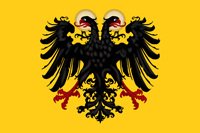 The Holy Roman Empire was a political entity in Western, Central, and Southern Europe that developed during the Early Middle Ages and continued until its dissolution in 1806 during the Napoleonic Wars. From the accession of Otto I in 962 until the twelfth century, the Empire was the most powerful monarchy in Europe. The empire reached the apex of territorial expansion and power in the mid-thirteenth century, but overextending led to partial collapse. Emperors, resulting in the Investiture Controversy. Popes such as Gregory VII justified the subsequent warfare against the Emperor's partisans in theological terms. It became acceptable for the Pope to utilize knights in the name of Christendom, not only against political enemies of the Papacy, but also against Al-Andalus, or, theoretically, against the Seljuq dynasty in the east.
The Holy Roman Empire was a political entity in Western, Central, and Southern Europe that developed during the Early Middle Ages and continued until its dissolution in 1806 during the Napoleonic Wars. From the accession of Otto I in 962 until the twelfth century, the Empire was the most powerful monarchy in Europe. The empire reached the apex of territorial expansion and power in the mid-thirteenth century, but overextending led to partial collapse. Emperors, resulting in the Investiture Controversy. Popes such as Gregory VII justified the subsequent warfare against the Emperor's partisans in theological terms. It became acceptable for the Pope to utilize knights in the name of Christendom, not only against political enemies of the Papacy, but also against Al-Andalus, or, theoretically, against the Seljuq dynasty in the east.
To the east of Europe lay the Byzantine Empire, composed of Christians who had long followed a separate Orthodox rite; the Eastern Orthodox and Roman Catholic churches had been in schism since 1054. Historians have argued that the desire to impose Roman church authority in the east may have been one of the goals of the crusade, although Urban II, who launched the First Crusade, never refers to such a goal in his letters on crusading. The Seljuq Turks had taken over almost all of Anatolia after the Byzantine defeat at the Battle of Manzikert in 1071; however, their conquests were piecemeal and led by semi-independent warlords, rather than by the sultan. A dramatic collapse of the empire's position on the eve of the Council of Clermont brought Byzantium to the brink of disaster. By the mid-1090s, the Byzantine Empire was largely confined to Balkan Europe and the northwestern fringe of Anatolia, and faced Norman enemies in the west as well as Turks in the east. In response to the defeat at Manzikert and subsequent Byzantine losses in Anatolia in 1074, Pope Gregory VII had called for the milites Christi ("soldiers of Christ") to go to Byzantium's aid. This call was largely ignored and even opposed. The reason for this was that while the defeat at Manzikert was shocking, it had limited significance and did not lead to major difficulties for the Byzantine empire, at least in the short term.
Situation in the East
Until the crusaders' arrival the Byzantines had continually fought the Seljuqs and other Turkish dynasties for control of Anatolia and Syria. The Seljuqs, who were orthodox Sunni Muslims, had formerly ruled the Great Seljuq Empire, but by the time of the First Crusade it had divided into several smaller states after the death of Malik-Shah I in 1092.
Malik-Shah was succeeded in the Anatolian Sultanate of Rum by Kilij Arslan I, and in Syria by his brother Tutush I, who died in 1095. Tutush's sons Fakhr al-Mulk Radwan and Duqaq inherited Aleppo and Damascus respectively, further dividing Syria amongst emirs antagonistic towards each other, as well as Kerbogha, the atabeg of Mosul.
Egypt and much of Palestine were controlled by the Arab Shi'ite Fatimid Caliphate, which was significantly smaller since the arrival of the Seljuqs. Warfare between the Fatimids and Seljuqs caused great disruption for the local Christians and for western pilgrims. The Fatimids, under the nominal rule of caliph al-Musta'li but actually controlled by vizier al-Afdal Shahanshah, had lost Jerusalem to the Seljuqs in 1073 (although some older accounts say 1076); they recaptured it in 1098 from the Artuqids, a smaller Turkish tribe associated with the Seljuqs, just before the arrival of the crusaders.
HISTORY
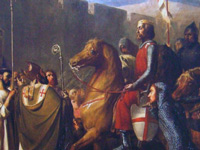
RESOURCES
This article uses material from the Wikipedia article "First Crusade (1095–1099)", which is released under the Creative Commons Attribution-Share-Alike License 3.0.
© Stories Preschool. All Rights Reserved.
